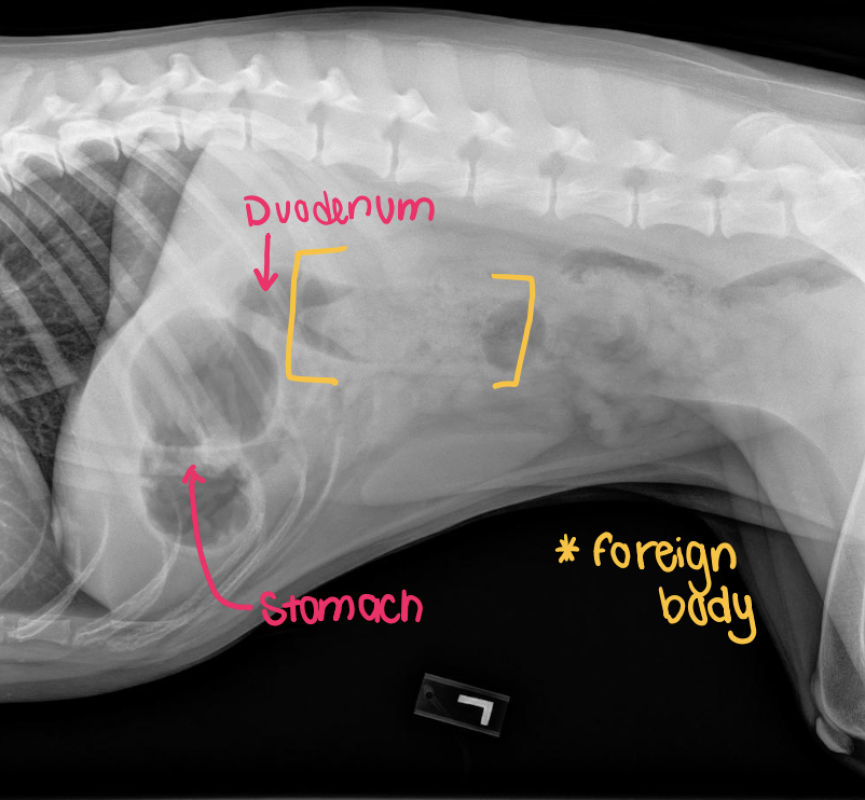The Case of The Missing Toy
Written by Samantha McBeth • 2024 Scholar
History
Luna is a 2-year-old, female spayed Labrador retriever who presented on 7/13/2024 to IVS for vomiting. Luna vomited 3-4 times consisting of mucus, phlegm, and food. Her vomiting episodes occurred within an hour of eating. Luna and her housemate ate 5 toys and 2 were still unaccounted for upon presentation.
Physical Exam
Upon Physical exam, Luna had a tense painful abdomen on palpation, tacky mucous membranes, and tachycardia. Luna was also having vomiting and regurgitation. Her attitude/demeanor was quite alert responsive. Everything else was within normal limits. Luna received a pain score of 1 out of 4.
Diagnostics
Bloodwork
Initial blood work
Luna was hemo-concentrated with elevated red blood cells (RBC) and hemoglobin (HGB) a finding that demonstrates dehydration. Luna’s PCV was also elevated at 70%, normal reference interval is 35-55%, also demonstrating dehydration. Her Total Protein was also elevated 7.3, 5.5-7.2 g/dL. This is consistent with Luna’s vomiting. Luna also had elevated ALT and LIPA. ALT is a liver enzyme and elevated numbers are indicative of liver injury. LIPA is the lipase enzyme which is mainly produced by the pancreases to break down fat. In this case it was elevated because of the inflammation the pancreases had due to the foreign body location causing irritation.
Recheck blood work
Prior to surgery Luna’s PCV and TP were rechecked. At 66% PCV and 6.8 TP she was prepped for surgery. Prior to discharge Luna’s PCV and TP were rechecked again and were normalized at 46.1% PCV and 5.1 TP. At this time, bloodwork was also rechecked with her ALT returned to normal reference interval. This is indicative that the foreign body was causing inflammation of the pancreas and injury to the liver. Removing it resolved the irritation.
Radiographs

Abdominal radiographs were sent to IDEXX to be read by a board-certified radiologist.
Conclusions: Foreign material was identified in the proximal duodenum. Mild reduction in size of the liver was also noted which could be a normal variation for this animal.
Recommendations: Abdominal exploration was recommended.
Prognosis
The prognosis was found to be “Good”. Typically, after removing the foreign body values return to normal. With intestinal foreign bodies prognosis decreases if there is perforation as sepsis can result. The GI is highly contaminated and spillage into the sterile abdomen can cause peritonitis and septicemia. This would decrease the prognosis.
Treatment
Luna was hospitalized and pre-operatively prepared with fluids ( PhyLyte), anti-nausea ( Cerenia and ondansetron), and pain medications ( Fentanyl Ketamine CRI) . For surgery, Luna was premedicated with a FKCRI bolus, induced with propofol, and maintained on isoflurane. Having a good cuff seal on the endotracheal tube, to prevent aspiration, was especially important as Luna was having regular incidence of regurgitation. Luna was placed in dorsal recumbency and an incision was made into her abdomen. Luna had an abdominal exploratory. The Foreign body was located in Luna’s duodenum. Luna’s entire gastrointestinal tract was then run to make sure there were no other obstructions or abnormalities. After assuring there was only a duodenum obstruction, the foreign body was milked as far aborad as possible. When it could not be milked anymore an incision was made into the duodenum to remove the foreign body. Once removed the intestines were closed with tapered 0 PDS in a simple continuous pattern. Prior to closing the abdomen, it was lavage with sterile saline three times. The linea alba was then closed with a simple continuous pattern. Followed by the subcutaneous closure via simple continuous. The skin layer was closed with sterile skin staples. During surgery Luna had ypothermia maintaining a temperature around 98 degrees Fahrenheit. Luna was on a hotdog with warming bottles to try and combat the hypothermia. Post operation Luna had a bear hugger heater to prevent further hypothermia. When Luna was extubated, she had regurgitated bile spill out. It was important to keep her head down as to not aspirate any of it. Luna was monitored every 15 minutes for an hour post operation.
Luna recovered well and was sent home on codeine and gabapentin for pain management. Sucralfate for GI protection. Trazodone for anxiety. With instruction to be on strict rest, e-collar, bland diet, and monitor incision for swelling, redness, and discharge Luna came back 3 days later with a surgical seroma and went home with more codeine for pain management.
References
- Anemia in dogs: VCA Animal Hospitals. Vca. (n.d.). https://vcahospitals.com/know-your-pet/anemia-in-dogs#:~:text=These%20tests%20are%20often%20performed,dog%20is%20generally%20considered%20anemic.
- Chemistry (cobas). Cornell University College of Veterinary Medicine. (n.d.). https://www.vet.cornell.edu/animal-
health-diagnostic-center/laboratories/clinical-pathology/reference-intervals/chemistry-cobas - Gastro-intestinal foreign bodies (DO’s and don’ts) - WSAVA 2015 Congress - Vin. Powered By VIN. (n.d.). https://www.vin.com/apputil/content/defaultadv1.aspx?id=7259318&pid=14365#:~:text=Prognosis%20after%20foreign%20body%20removal,%2C%20diverticula%2C%20and%20stricture%20formation.
- Gastrointestinal obstruction in small animals - gastrointestinal obstruction in small animals. Merck Veterinary Manual. (n.d.). https://www.merckvetmanual.com/digestive-system/diseases-of-the-stomach-and-intestines-in-small-animals/gastrointestinal-obstruction-in-small-animals#Treatment_v3266549
- Lipase interpretive summary. (n.d.). https://www.idexx.no/files/8113-us-lipase-interpretive-summary.pdf


